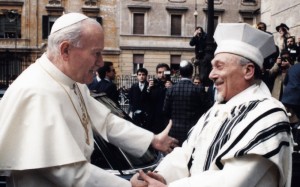On Sunday, just days before his hundredth birthday, Elio Toaff, the former chief rabbi of Rome, died. A great promoter of Catholic-Jewish dialogue and friend of St. John Paul II, Rabbi Toaff was witness to an age when Catholics and Jews – who trace a common spiritual lineage to Abraham and share the Old Testament, yet were often separated by history – dramatically abandoned old prejudices.
Although Christianity grew out of Judaism, relations between Christians and Jews have often been painful. In 1215, the Fourth Lateran Council decreed that Jews wear special clothing to distinguish them from Christians. In 1555, Pope Paul IV created a Jewish ghetto in Rome, which was the last European ghetto until it was abolished in 1888. Many Christians accused Jews of killing Christ, and Good Friday passion plays not infrequently inspired anti-Jewish violence across Europe.
Christian-Jewish relations, however, were not always marked by hostility. In the Middle Ages, Jews were often defended, notably by figures like St. Bernard of Clairvaux (which is why many Jews are still often named Bernard) and Pope Innocent IV. The papal court employed Jewish doctors, and Pope Gregory I urged tolerance for Jews as early as the seventh century. Nonetheless, distrust separated Jews and Christians for centuries.
In the twentieth century, this changed radically for the better. Today, Christian-Jewish ecumenical prayers are commonplace features of religious life worldwide. Church leaders routinely condemn anti-Semitism. Currently, the main nest of anti-Jewish sentiments in Catholicism is in the Society of St. Pius X, a schismatic group. Meanwhile, statements such as Cardinal Oscar Rodriguez Maradiaga’s outrageous claim that the Jewish-controlled media uses stories of sexual misconduct by Catholic priests in order to detract attention away from the Arab-Israeli conflict are the exception, not the norm in Catholic-Jewish relations.
This transformation was possible thanks to the good will of such people as Elio Toaff.
Born in Tuscany in 1915, the son of a rabbi, Toaff spent World War II fighting in Italy’s anti-Fascist resistance. He witnessed the Nazi massacre of over 500 civilians in Sant’Anna di Stazzema, Tuscany. In his last published interview, Toaff told the Jewish-Italian website Moked that he experienced hostility as a Jew living in Mussolini’s Italy, the Third Reich’s closest ally. The only reason he didn’t leave Europe was that he wouldn’t abandon his community at a time of peril.
Nonetheless, Toaff was able to appreciate the significant aid that a number of Catholics gave to Jews, despite pre-Vatican II prejudices. While it has become fashionable to speak of Pope Pius XII as a “silent pope,” Pius regularly condemned Nazism on Vatican Radio and appealed to Italian convents to shelter Jewish children, hiding many Jews himself in Castel Gandalfo and the Vatican.

Having seen the aid that Italian Catholics and the Vatican gave the Jews, Toaff – who became the chief rabbi of Rome in 1951 – remarked upon the death of Pius XII: “Jews will always remember what the Catholic Church did for them by order of the pope during the Second World War. When the war was raging, Pius spoke out very often to condemn the false race theory.”
Shortly thereafter, major changes came. St. John XXIII removed the prayer “for the conversion of the perfidious Jews” from the Good Friday liturgy, and in 1965 the Church promulgated Nostra Aetate, which declared that the Jews as a people were not guilty of killing of Christ.
Catholic-Jewish reconciliation accelerated after the election of St. John Paul II in 1978. He already had many Jewish friends in his native Poland; the closest of them, Jerzy Kluger, fought in the Polish Army as it helped liberate Italy from the Nazis. Kluger remained in Rome until his death, later providing a key link between the pope and the Jewish world.
Meanwhile, when Poland’s Communist government engaged in an anti-Semitic campaign in March 1968 and forced many Polish Jews to emigrate, Cardinal Karol Wojtyła visited a Cracow synagogue and expressed his solidarity with Poland’s Jews.
Providentially, Rabbi Toaff led Rome’s Jewish community at that time. In 1986, John Paul II made an official visit to Rome’s Great Synagogue, becoming the first pope since St. Peter to visit a Jewish temple. The two men greeted each other and prayed. The picture of the Polish pope and Italian rabbi embracing each other and smiling has become one of the most iconic images of John Paul’s pontificate. Toaff was the initiator of this historic event, himself having invited John Paul II to visit Rome’s Great Synagogue. It was on that occasion that the pope for the first time pronounced that the Jews were “elder brothers in the faith,” a phrase borrowed from Adam Mickiewicz, Poland’s philo-Semitic national poet.
The two men instantly became friends. Later in the same year, John Paul II invited Toaff to pray with him and the leaders of many of the world’s religions at the ecumenical World Day of Prayer for Peace in Assisi. In 1994, Toaff and John Paul II co-officiated a concert in the Vatican to commemorate the victims of the Shoah. Meanwhile, Toaff helped organize John Paul II’s visit to the Holy Land in 2000. Toaff was one of two people mentioned in the pope’s will, the other being his secretary, Archbishop (now Cardinal) Stanisław Dziwisz.
Having witnessed fascism and the Nazi occupation of Italy, anti-Semitism and the rebirth of Rome’s Jewish community, Rabbi Elio Toaff was a witness to his country’s Jewish history. But above all, he had a heart open to dialogue and reconciliation. His gestures towards Catholics and friendship with St. John Paul II played a crucial role in the true miracle that was the radical change from the era of mutual distrust to that in which Jews are once again our “elder brothers.” Alav Ha-sholom.














